
 Eleni’s Cookies Eleni’s Cookies invites you to celebrate spring and Please Eat The Daisies.
|
 |
Gourmet News Archives
May 2005
5.30.05
Inside Joan Jetson’s Kitchen. The annual conference and showcase for kitchen and bath designers concluded recently. Among the gorgeous cabinets, countertops, and appliances that made even those with beautiful kitchens want to renovate was the promise of what’s just out of reach: the kitchen of the near future.
For more than five years, research has been harkening the arrival of the Joan Jetson’s kitchen; but like the cashless society, it’s still a few years away. The closest you can get today is a multi-media refrigerator from LG with a computer and a monitor built into the door.* You be the first on your block to use it instead of a countertop computer to download recipes, get e-mail, and leave video messages for family members; save counter space and watch TV and DVDs. But a portable laptop and TV have more flexibility today; and the real the functionality promise—that RFID tags (radio frequency ID bar codes) on all the food products in your refrigerator and cabinets will create automatic lists to let you know when you’re running low and e-mail your shopping list to an online grocer (or let you download it to your PDA if you enjoy the 20th century practice of shopping in person)—might or might not get here by the next decade.
*The model with the computer will be on the market by the end of the year. Currently you can buy a 25.2 cubic foot model with a 13.1" TV monitor and stereo beginning at about $3,000 (model #LRSC26980, at right). Yes, there is a remote control and you can hook up a DVD or VCR.
While you wait for RFID, WiFi, and other technologies to catch up, what else may be coming to a kitchen near you one of these years? Scientists at the Counter Intelligence Group (get it?) at the MIT Media Lab have been working on these:
- The RFID tags that inventory your ingredients will also let you know if you have what it takes to make any particular recipe.
- A projector on the ceiling, linked to the computer, will beam the recipe onto the counter so you don’t have to flip cookbook pages; or a computerized voice can walk you through it.
|
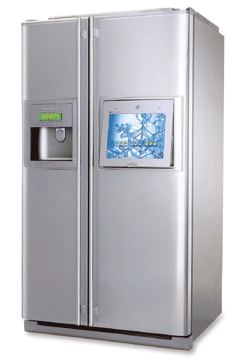 |
- Countertops, sinks and other surfaces all will be height-adjustable, making the kitchen more comfortable and efficient for everyone.

Not Judy Jetson’s kitchen, but one that you can have today. Photo courtesy of Kitchen & Bath Business. |
- A programmable toaster that will be able to pull a greeting, a daily horoscope or a stock price off the Internet and burn it onto the bread.
- Doing the dishes could be eliminated with a dish-making machine. Using a sheet of acrylic, it produces exactly the dishes needed for each mail. Afterward, the dishes are thrown back in; the food residue is skimmed off and the plastic and melted down. A real space saver too, since only the small amount of acrylic needs to be stored.
|
5.23.05
When the foods you love are GOOD for you. There’s more good news for foodies: People who eat lots of olive oil and dark chocolate, and drink lots of tea and wine seem to live longer and suffer less cancer and heart disease.
About 250 physicians and diet from across the globe attending last week’s Diet and Optimum Health conference at Oregon State University in Portland. Despite the recent re-configuration of the general U.S. diet pyramid, the group generally recommends a Mediterranean diet to patients for heart health. That includes lots of fruits and vegetables, plus olive oil (up to one-quarter cup a day) plus nuts, dark chocolate and wine. The American Heart Association and American Cancer Society recommend similar diets—rich fruits, vegetables and whole grains.
Science researchers don’t know exactly how and why these foods fight illness, but the data indicates that people who consume them benefit.
“I think our evidence for food-based antioxidants is extremely strong. If you look at people who eat chocolate, they live longer,” said Dr. Miles Hassell, director of the Integrative Medicine Program at Providence Cancer Center. And Hassell wasn’t troubled when conference speakers couldn't pinpoint how those foods help health.
“If our data is clear that the Mediterranean diet saves lives, and we have nothing better, I don't care what the mechanism is,” he said.
“If you ask me, ‘Does tea prevent cancer?’” Rutgers University expert Chung Yang told a Portland health conference “my answer is 'Yes. No. Perhaps.’”
Here’s the latest scientific thinking:
TEA: Tea, especially less-processed white and green teas, contain lots of flavonoids— chemicals made by plants to protect against radiation and other damage. They seem to act as strong antioxidants in the body. Studies show tea may battle several cancers, including oral cancer and prostate tumors. Some suggest tea lowers risk for coronary artery disease. But other studies show no benefits, and none proves how tea might aid health.
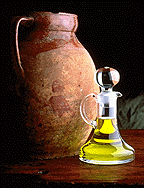 OLIVE OIL: Rich in flavonoids, olive oil is distinguishes the Mediterranean diet from others. That diet generally seems to lower blood pressure and heart disease risk. Is it due to olive oil? There is no current proof that olive oil is better than other vegetable oils, but researchers are working on it. People seeking flavonoid-rich olive oil should seek out extra virgin oils with a more bitter taste. Color is a poor measure, because producers can dye their oil green. OLIVE OIL: Rich in flavonoids, olive oil is distinguishes the Mediterranean diet from others. That diet generally seems to lower blood pressure and heart disease risk. Is it due to olive oil? There is no current proof that olive oil is better than other vegetable oils, but researchers are working on it. People seeking flavonoid-rich olive oil should seek out extra virgin oils with a more bitter taste. Color is a poor measure, because producers can dye their oil green.
CHOCOLATE: Cacao has been used in medicine from the time of the Toltecs, 3,000 years ago. Modern studies suggest it may improve the way blood vessels react, perhaps limiting heart disease. We know dark chocolate is a powerful antioxidant: Two ounces of dark chocolate has roughly as many antioxidants as two glasses of red wine, six apples or a pound of red onions. The higher the percentage of cacao, the more flavonoids the chocolate has.
ALCOHOL: Many studies show people who generally have fewer than three drinks a day have a significantly lower risk of dying from heart disease. The drinks are standard sizes—12 ounces of beer, 4.5 ounces of wine and 1.5 ounces of 80-proof liquor.
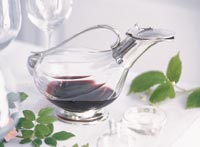 However, alcohol does not help everyone. Some studies suggest even moderate drinking may increase the risk of breast cancer. Heavy drinking causes serious problems, including cirrhosis, several cancers and heart disease. However, alcohol does not help everyone. Some studies suggest even moderate drinking may increase the risk of breast cancer. Heavy drinking causes serious problems, including cirrhosis, several cancers and heart disease.
Although many studies indicate wine is healthier than other alcohol, it may not matter which drink you order at the bar of better health. U.S. wine drinkers tend to be wealthier and healthier than average, which may explain why wine looks better in studies than beer or hard alcohol.
5.16.05
Tea: the new health food? At the American Dietetic Association’s (ADA) annual Nutrition News Forecast meeting in San Diego this week, results reported by a research team from Michigan State University showed that tea is the major source of flavonoid antioxidants in the U.S. diet, supplying 55 percent of the estimated 134 mg/day. Clinical studies have shown that tea flavonoids may promote good heart health by improving endothelial function and by reducing blood cholesterol levels.
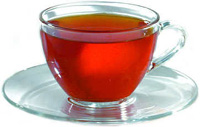 While further investigation of the relationship between flavonoid intake and prevalence of chronic diseases is needed, this means that we may be able to realize health benefits by doing something as simple as drinking more tea. While further investigation of the relationship between flavonoid intake and prevalence of chronic diseases is needed, this means that we may be able to realize health benefits by doing something as simple as drinking more tea.
Several studies have found that tea drinking may be good for the heart. For most Americans, drinking a cup of tea a day, hot or cold, will increase their daily flavonoids by over 50 percent. This in turn, may further reduce risk for chronic diseases. A number of population studies conducted around the world, including studies in the United States and Europe, have consistently found that drinking black tea is associated with a reduced risk of heart disease. Three separate analyses of research indicated that drinking three cups of tea daily was associated with about a 10 to 12 percent lower risk of cardiovascular disease death or heart attack in the populations studied.
Other major food groups contributing to flavonoid intake include fruits; vegetables; and the bread, cereals, rice and pasta group.
Industry Stats. We recently returned from the mid-year sessions of the food industry shows where we find many of the products we share with you on THE NIBBLE™: The Fancy Food Show, presented by the National Association of Specialty Food Trades (NASFT), and All Things Organic™, presented by the Organic Trade Association (OTA). Between the two, there were more than 50,000 foods and beverages to see and sample. We nibbled our way to some wonderful new discoveries that will soon appear on these pages and in THE NIBBLE’s newsletter.
The NASFT released a special report with some information of interest to people who buy specialty foods:
- Specialty foods are growing at a rate more than double that of mass-market products: 17.9% for specialty foods versus 7.7% for all foods.
- 5,211 specialty food products were introduced in 2004, with beverages recording the most new product introductions: 1,020. Beverages eclipsed sauces and seasonings, which had been the product growth leader since 2000. Other categories that showed strong growth were bakery, confectionary, snacks, desserts and ice cream, and meals and meal centers.
|

Fizzy Lizzy soda in Fuji Apple flavor —one of the brands in the segment’s growth spurt. |
- Sales of specialty foods at retail were $24.7 billion in 2004: 66% purchased at supermarkets, 23.3% at specialty food stores, approximately 8% at natural food stores, and the remainder at online stores.
- The specialty foods category grew 16% between 2002 and 2004. Segments that grew the fastest (new product introductions) and also are the biggest sellers are condiments; sauces and seasonings; cheese; milk, eggs and other dairy products*; and beverages. The fifth fast-growth segment is nuts, seeds, dried fruits and trail mixes.
- Specialty food manufacturers tend to be small, entrepreneurial businesses. Nearly 8% of survey responders had miniscule sales under $50,000, and 7 of 10 manufacturers have sales of less than $3 million. Only 5.9% do in excess of $10 million Average sales for industry manufacturers are $1 million.
- Employment figures support the fact that many specialty food retailers are smaller operations: 31.9% had only one or no full-time staff in 2004, suggesting that they are family operations. For those with employees have a surprisingly low turnover rate: more than two-thirds report 0-10% turnover in an average year. Conclusion: manufacturer, retailer, employee, consumer— specialty foods are a happy sector.
*Includes organic products. Overall organic food sales were $11 billion in 2004.
5.09.05
Champion Cheeses. The champion has been crowned at the 2005 United States Champion Cheese Contest, sponsored by the Wisconsin Cheese Makers Association. It is a classic Emmentaler made by Randy Krahenbul of Indiana’s Fair Oaks Dairy Products. First Runner-Up is an aged Raclette made by John Hoyt at Leelanau Cheese, Suttons Bay, MI. Second Runner-Up is Cocoa Cardona, a semisoft goat’s milk cheese rubbed with cocoa made by Sid 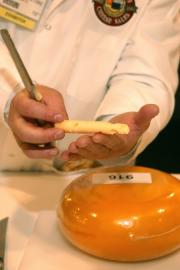 Cook at Carr Valley Cheese, La Valle, WI. Like the Olympics, final scores were razor-close, with the podium winners scoring 98.55, 98,34286, and 98.323, respectively, out of 100 possible points. There were 1,008 entries in 42 classes of cheese (brie/camembert, sheep’s milk, mozzarella, fresh mozzarella, blue veined, spreadable, snack, et al). Cook at Carr Valley Cheese, La Valle, WI. Like the Olympics, final scores were razor-close, with the podium winners scoring 98.55, 98,34286, and 98.323, respectively, out of 100 possible points. There were 1,008 entries in 42 classes of cheese (brie/camembert, sheep’s milk, mozzarella, fresh mozzarella, blue veined, spreadable, snack, et al).
Gold, silver and bronze medals were awarded in each class. Then all gold medalists were re-evaluated to choose the United States Champion and the two runners-up. Of the 42 gold medalists, 16 were from Wisconsin, with New York and California the next best-represented, each having five gold medalists in the final round.
The American Cheese Society conducts the largest annual competition, to be held later this month. The 2003 winner, Red Hawk from Cowgirl Creamery, was a big pick in THE NIBBLE™ newsletter. You can read the review here.
Click here for a list of all 42 best-of-class winners. We’re off to hunt down as many of them as we can find at our local cheese store.
5.02.05
Trekkers treat. Looking for something a tad different on your grill? Safari Sausage™ by Scarsdale Braai, is an Americanized version of South Africa’s most popular barbecue food: a savory beef sausage that brings life to the grill. Based on a traditional recipe that marries the legends of the trekkers, the spirit of Africa and the exotic spices the Cape Town’s Javanese culture, this exciting product is now available in convenient brown and serve packaging. BBQ’ers will quickly develop a longing for this flavorful meat when matched with a malty brew or one of South Africa’s solid wines—a full bodied chenin blanc or a rock solid pinotage, also from the rich Cape region.
Safari Sausage uses a gentle steam cooking process to lock in all the flavors of traditional boerewors in an easy to prepare product. You just put the precooked meat on a grill to heat and flavor. The laborious slow cooking has been done. They can also be heated on an electric grill, even a microwave, with all the traditional flavoring preserved. Shelf life is 3 weeks, and the product can be frozen for up to 6 months. Great for barbeques, mixed grills strong pastas, exotic pizzas, and fantastic omelets. Available in beef. (Other flavors and a dried snack version are expected to follow.) $6 a pound. For more info: www.scarsdalebraai.com.
Lifestyle Direct Direct, Inc. All rights reserved. Images are the copyright of their respective owners.

|







 OLIVE OIL: Rich in flavonoids, olive oil is distinguishes the Mediterranean diet from others. That diet generally seems to lower blood pressure and heart disease risk. Is it due to olive oil? There is no current proof that olive oil is better than other vegetable oils, but researchers are working on it. People seeking flavonoid-rich olive oil should seek out extra virgin oils with a more bitter taste. Color is a poor measure, because producers can dye their oil green.
OLIVE OIL: Rich in flavonoids, olive oil is distinguishes the Mediterranean diet from others. That diet generally seems to lower blood pressure and heart disease risk. Is it due to olive oil? There is no current proof that olive oil is better than other vegetable oils, but researchers are working on it. People seeking flavonoid-rich olive oil should seek out extra virgin oils with a more bitter taste. Color is a poor measure, because producers can dye their oil green. However, alcohol does not help everyone. Some studies suggest even moderate drinking may increase the risk of breast cancer. Heavy drinking causes serious problems, including cirrhosis, several cancers and heart disease.
However, alcohol does not help everyone. Some studies suggest even moderate drinking may increase the risk of breast cancer. Heavy drinking causes serious problems, including cirrhosis, several cancers and heart disease.

 Cook at Carr Valley Cheese, La Valle, WI. Like the Olympics, final scores were razor-close, with the podium winners scoring 98.55, 98,34286, and 98.323, respectively, out of 100 possible points. There were 1,008 entries in 42 classes of cheese (brie/camembert, sheep’s milk, mozzarella, fresh mozzarella, blue veined, spreadable, snack, et al).
Cook at Carr Valley Cheese, La Valle, WI. Like the Olympics, final scores were razor-close, with the podium winners scoring 98.55, 98,34286, and 98.323, respectively, out of 100 possible points. There were 1,008 entries in 42 classes of cheese (brie/camembert, sheep’s milk, mozzarella, fresh mozzarella, blue veined, spreadable, snack, et al).